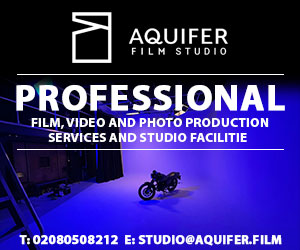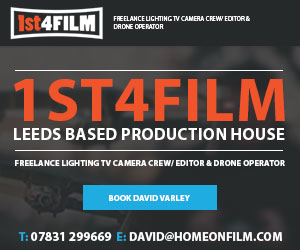Broadcast News
09/05/2019
Meet The Colourist

Since starting at Splice in London 12 years ago, Adam Dolniak has graded many different projects such as the biopics England is Mine and My Name is Lenny, the documentary Fighting For A City, and the TV comedy series The Reluctant Landlord and Plebs.
Recently Adam was awarded the RTS Craft & Design Award for Picture Enhancement for his work on the Channel 4 documentary The UN Sex Abuse Scandal, directed by Sam Collyns.
Where did you study?
I studied something completely unrelated to television and film - Pharmacology at the University of Cardiff’s College of Medicine. It was pretty interesting stuff and I enjoyed the degree, but after graduating the career options weren’t what I'd hoped for and I needed to reassess my path.
I moved to London and found work as a commercial traffic assistant for a number of music channels, back when music TV was still a ‘thing’. I ordered the ads ready for transmission. From there I was asked to encode the ads from DigiBeta – and that's when I started to familiarise myself with VT operating and the edit support team.
What brought you to colour?
I was an online editor on Avid DS for over eight years. As there was no grading suite at Splice back then; all the colour correction, VFX and finishing was completed on the Avid DS. It was a great tool and a real shame it was discontinued, I actually really miss using it!
I'm not sure you can completely separate the two worlds of grading and finishing; there are so many disciplines that are interchangeable between the two. For me, that period of online editing was really important to my understanding of colour correction and all the technical and creative knowledge that I gained was the perfect springboard onto Baselight. Importantly, I can confidently advise clients of what can be best achieved in the grade, or point out when they'll get better results in a VFX suite. At the end of the day, I'm always striving to give clients the best possible end product.
There's something really very satisfying about being responsible for the whole finishing process; to sit back at the end of the day and watch your work is particularly rewarding.
Where were you working before Splice?
I worked at a busy post facility in Soho called Resolution, providing tech support to pretty much everything from Pro Tools suites, to the online and offline Avid edits as well as the VFX suites. It was long shifts, often overnight and I did that for a long time; it was an invaluable learning experience.
At that time I still didn’t really know which direction I wanted to go in, I just knew I didn’t want to offline edit. They did have a Pandora Pogle system there as a linear grading suite but it was a very complicated setup so I never got to try it out.
It was when I onlined my first series at Splice that I realised how much I enjoyed the finishing process.
You have worked on many different formats and subjects. What is your approach to grading such a variety of projects?
The great thing about being at Splice is the sheer variety of work. In the same week, I can go from grading a broadcast documentary, to a feature film, a global commercial campaign or a music video. The schedule can be a hungry beast.
Each genre requires a different approach, not only from the creative aspect but also how to manage the session and the different types of clients. With short form, you might have up to 15 people in the room, all with their own creative opinions, and you are conducting that situation. But with long form, it might just be you and the director for days at a time, and you build a really tight working relationship.
I love the mix of it.
Going from the intensity of broadcast work - where you have to get through over a thousand shots in nine hours - to the luxury of time on commercials or features is a dream.
Congratulations for the RTS Craft & Design Award for Picture Enhancement for the Channel 4 documentary The UN Sex Abuse Scandal. What brought you to such an intense project?
Splice has worked with Ronachan Films, the production company, quite frequently over the last few years and I had graded their feature documentary Oink!: Life in Eight Chapters in 2017. So they brought the project to us, and of course, we wanted to be involved with such an important story.
How did you approach the look?
To start with, the majority of the film was shot on a Canon C300 but I had a limited range to work with as it was shot in Rec709 with whatever available light there was - often in challenging situations. Generally, this meant that the footage was very saturated, very bright with harsh blacks and peaking highlights. I felt the over-saturation and brightness of the footage didn’t sit comfortably with the serious subject matter. I wanted to sculpt the grade around the mood of the story to do it justice.
However, in some situations the bright sunlight also created some backlit scenes with silhouettes. It was much more beautiful to embrace those shadows than try to force recovery of any detail.
The other cameras used were drones - DJI Osmo and ARRI ALEXA – combined with a fair amount of historical and news archive of varying quality. So technically there was some camera matching to do.
I finished the look with Baselight’s film grain tool, which I love; it can completely transform the underlying mood of a film or scene without being too obvious. It can quickly create grittiness or even a certain emotional appeal - adding grain texture to the clipped highlights added a bit more depth and took away that video edge.
How long did it take to grade? What part of the grading process did you prioritise?
Despite the powerful content, the budget still only allowed for one day to grade - 10 hours. This is fairly typical for broadcast documentaries and means I have to work quickly and efficiently to make the most of the project, its scenery, and its story.
There is a night-time scene where Ramita Navai accompanies a UN convoy, which was particularly problematic. The camera sensor must have struggled in the low light and everything came out looking extremely saturated, noisy and red. But the composition of the images and the lighting from the vehicles was beautiful, and I could see the potential for this whole scene to look quite atmospheric. I used the grade tools to recover as much as I could and steer it into a much more natural direction – this particular scene took me quite some time to finalise.
Another priority, because of the sensitive subject matter, was to disguise the contributors and the victims. I made use of the shadows, clipping and lifting the blacks in those instances, which sat well with the overall grade. This approach was also very helpful in hiding the video noise in some of the underexposed images.
The skin tones are vibrant. Could you share with us some tips?
The warm vibrant sunlight of Central Africa was beautiful - that certainly helped. But I think with darker skin tones I focus much more on getting the perfect contrast. Softening the darker areas, and using the Film Grade to adjust overall temperature, added subtle tones to the shadows. With selective desaturation and film grain, I got some great results.
How did Baselight help you to achieve that look?
To achieve the look I wanted within the tight time frame – that’s where Baselight and the Blackboard panel really come into their own.
Every grade session is essentially a compromise between what you can achieve in the given timeframe and your vision for the finished product. Baselight steps in to bridge that gap so that you can achieve great results quickly without having to cut corners and compromise your vision.
With my experience in broadcast television, I’m used to having to get through a lot of shots in one day. Over time, I’ve explored techniques and shortcuts to speed up my work without sacrificing the quality of the finish. You end up with a very useful box of tricks that allows you to work quickly and efficiently, regardless of the genre.
What tools from Baselight do you use the most and why?
I'd say I use a 50/50 mix of Video Grade and Film Grade as my primary on most broadcast jobs; for drama or comedy I prefer to use the colour transform pipeline and work in ACES, with the Film Grade and curves being more prominent.
Film Grade offers a fast way to make multiple adjustments without getting too complicated. You can isolate areas and make secondary corrections without needing to add other tools or shapes, and by simply changing the pivot point you can get even more subtle adjustments in specific areas. What might be done over four or five layers can all be done by one operator.
Also, when matching shots across a scene I'm a huge fan of the snapshot feature - and it’s always a hit with clients. It’s like a magnifying glass to double-check your finer details.
Would you say there are some trends in colour grading?
It’s difficult to say if there is any one specific trend in grading - each director seeks to get their own individual identity on screen.
I think you need to analyse the story, subject matter or product and base your creative direction on that. There’s a vast and ever-changing range of ideas in colour grading and that’s what makes my job so engaging.
Which artist inspires you the most and why?
I don’t have a favourite artist... I take inspiration from what I see in film and television.
I suppose I build up a scrapbook of ideas in my mind with which to experiment later. Even if something doesn't have the most riveting storyline, if it looks interesting I can get absorbed by the visuals.
I appreciate all types of films - great character driven pieces like American Psycho to entertainment blockbusters like Avatar.
Two of the best-looking films in my eyes are Interstellar and Inglorious Basterds. The cinematography is so beautiful, I don’t think I'll ever get bored of watching them!
Any upcoming projects you would like to share?
There's a Netflix Original series that I'm really excited about as it will be first experience finishing in Dolby Vision. Then there's the fifth series of ITV2's Plebs this summer and a three-part BBC documentary series called Forensics. Plus a feature film called Rose Plays Julie.
And lots more that I can't talk about, but 2019 is definitely shaping up to be a good year.
Recently Adam was awarded the RTS Craft & Design Award for Picture Enhancement for his work on the Channel 4 documentary The UN Sex Abuse Scandal, directed by Sam Collyns.
Where did you study?
I studied something completely unrelated to television and film - Pharmacology at the University of Cardiff’s College of Medicine. It was pretty interesting stuff and I enjoyed the degree, but after graduating the career options weren’t what I'd hoped for and I needed to reassess my path.
I moved to London and found work as a commercial traffic assistant for a number of music channels, back when music TV was still a ‘thing’. I ordered the ads ready for transmission. From there I was asked to encode the ads from DigiBeta – and that's when I started to familiarise myself with VT operating and the edit support team.
What brought you to colour?
I was an online editor on Avid DS for over eight years. As there was no grading suite at Splice back then; all the colour correction, VFX and finishing was completed on the Avid DS. It was a great tool and a real shame it was discontinued, I actually really miss using it!
I'm not sure you can completely separate the two worlds of grading and finishing; there are so many disciplines that are interchangeable between the two. For me, that period of online editing was really important to my understanding of colour correction and all the technical and creative knowledge that I gained was the perfect springboard onto Baselight. Importantly, I can confidently advise clients of what can be best achieved in the grade, or point out when they'll get better results in a VFX suite. At the end of the day, I'm always striving to give clients the best possible end product.
There's something really very satisfying about being responsible for the whole finishing process; to sit back at the end of the day and watch your work is particularly rewarding.
Where were you working before Splice?
I worked at a busy post facility in Soho called Resolution, providing tech support to pretty much everything from Pro Tools suites, to the online and offline Avid edits as well as the VFX suites. It was long shifts, often overnight and I did that for a long time; it was an invaluable learning experience.
At that time I still didn’t really know which direction I wanted to go in, I just knew I didn’t want to offline edit. They did have a Pandora Pogle system there as a linear grading suite but it was a very complicated setup so I never got to try it out.
It was when I onlined my first series at Splice that I realised how much I enjoyed the finishing process.
You have worked on many different formats and subjects. What is your approach to grading such a variety of projects?
The great thing about being at Splice is the sheer variety of work. In the same week, I can go from grading a broadcast documentary, to a feature film, a global commercial campaign or a music video. The schedule can be a hungry beast.
Each genre requires a different approach, not only from the creative aspect but also how to manage the session and the different types of clients. With short form, you might have up to 15 people in the room, all with their own creative opinions, and you are conducting that situation. But with long form, it might just be you and the director for days at a time, and you build a really tight working relationship.
I love the mix of it.
Going from the intensity of broadcast work - where you have to get through over a thousand shots in nine hours - to the luxury of time on commercials or features is a dream.
Congratulations for the RTS Craft & Design Award for Picture Enhancement for the Channel 4 documentary The UN Sex Abuse Scandal. What brought you to such an intense project?
Splice has worked with Ronachan Films, the production company, quite frequently over the last few years and I had graded their feature documentary Oink!: Life in Eight Chapters in 2017. So they brought the project to us, and of course, we wanted to be involved with such an important story.
How did you approach the look?
To start with, the majority of the film was shot on a Canon C300 but I had a limited range to work with as it was shot in Rec709 with whatever available light there was - often in challenging situations. Generally, this meant that the footage was very saturated, very bright with harsh blacks and peaking highlights. I felt the over-saturation and brightness of the footage didn’t sit comfortably with the serious subject matter. I wanted to sculpt the grade around the mood of the story to do it justice.
However, in some situations the bright sunlight also created some backlit scenes with silhouettes. It was much more beautiful to embrace those shadows than try to force recovery of any detail.
The other cameras used were drones - DJI Osmo and ARRI ALEXA – combined with a fair amount of historical and news archive of varying quality. So technically there was some camera matching to do.
I finished the look with Baselight’s film grain tool, which I love; it can completely transform the underlying mood of a film or scene without being too obvious. It can quickly create grittiness or even a certain emotional appeal - adding grain texture to the clipped highlights added a bit more depth and took away that video edge.
How long did it take to grade? What part of the grading process did you prioritise?
Despite the powerful content, the budget still only allowed for one day to grade - 10 hours. This is fairly typical for broadcast documentaries and means I have to work quickly and efficiently to make the most of the project, its scenery, and its story.
There is a night-time scene where Ramita Navai accompanies a UN convoy, which was particularly problematic. The camera sensor must have struggled in the low light and everything came out looking extremely saturated, noisy and red. But the composition of the images and the lighting from the vehicles was beautiful, and I could see the potential for this whole scene to look quite atmospheric. I used the grade tools to recover as much as I could and steer it into a much more natural direction – this particular scene took me quite some time to finalise.
Another priority, because of the sensitive subject matter, was to disguise the contributors and the victims. I made use of the shadows, clipping and lifting the blacks in those instances, which sat well with the overall grade. This approach was also very helpful in hiding the video noise in some of the underexposed images.
The skin tones are vibrant. Could you share with us some tips?
The warm vibrant sunlight of Central Africa was beautiful - that certainly helped. But I think with darker skin tones I focus much more on getting the perfect contrast. Softening the darker areas, and using the Film Grade to adjust overall temperature, added subtle tones to the shadows. With selective desaturation and film grain, I got some great results.
How did Baselight help you to achieve that look?
To achieve the look I wanted within the tight time frame – that’s where Baselight and the Blackboard panel really come into their own.
Every grade session is essentially a compromise between what you can achieve in the given timeframe and your vision for the finished product. Baselight steps in to bridge that gap so that you can achieve great results quickly without having to cut corners and compromise your vision.
With my experience in broadcast television, I’m used to having to get through a lot of shots in one day. Over time, I’ve explored techniques and shortcuts to speed up my work without sacrificing the quality of the finish. You end up with a very useful box of tricks that allows you to work quickly and efficiently, regardless of the genre.
What tools from Baselight do you use the most and why?
I'd say I use a 50/50 mix of Video Grade and Film Grade as my primary on most broadcast jobs; for drama or comedy I prefer to use the colour transform pipeline and work in ACES, with the Film Grade and curves being more prominent.
Film Grade offers a fast way to make multiple adjustments without getting too complicated. You can isolate areas and make secondary corrections without needing to add other tools or shapes, and by simply changing the pivot point you can get even more subtle adjustments in specific areas. What might be done over four or five layers can all be done by one operator.
Also, when matching shots across a scene I'm a huge fan of the snapshot feature - and it’s always a hit with clients. It’s like a magnifying glass to double-check your finer details.
Would you say there are some trends in colour grading?
It’s difficult to say if there is any one specific trend in grading - each director seeks to get their own individual identity on screen.
I think you need to analyse the story, subject matter or product and base your creative direction on that. There’s a vast and ever-changing range of ideas in colour grading and that’s what makes my job so engaging.
Which artist inspires you the most and why?
I don’t have a favourite artist... I take inspiration from what I see in film and television.
I suppose I build up a scrapbook of ideas in my mind with which to experiment later. Even if something doesn't have the most riveting storyline, if it looks interesting I can get absorbed by the visuals.
I appreciate all types of films - great character driven pieces like American Psycho to entertainment blockbusters like Avatar.
Two of the best-looking films in my eyes are Interstellar and Inglorious Basterds. The cinematography is so beautiful, I don’t think I'll ever get bored of watching them!
Any upcoming projects you would like to share?
There's a Netflix Original series that I'm really excited about as it will be first experience finishing in Dolby Vision. Then there's the fifth series of ITV2's Plebs this summer and a three-part BBC documentary series called Forensics. Plus a feature film called Rose Plays Julie.
And lots more that I can't talk about, but 2019 is definitely shaping up to be a good year.
Top Related Stories
Click here for the latest broadcast news stories.
20/11/2006
'A Good Year' Graded On Resolve And 4K DI Work
da Vinci Systems has announced that the newly released motion picture 'A Good Year' was graded on Resolve within a complete 4K Digital Intermediate (D
'A Good Year' Graded On Resolve And 4K DI Work
da Vinci Systems has announced that the newly released motion picture 'A Good Year' was graded on Resolve within a complete 4K Digital Intermediate (D
20/10/2022
Nominees For 2022 FilmLight Colour Awards Unveiled
FilmLight has unveiled the nominees for the 2022 FilmLight Colour Awards. In their second year, the awards have attracted over 300 entries from 36 cou
Nominees For 2022 FilmLight Colour Awards Unveiled
FilmLight has unveiled the nominees for the 2022 FilmLight Colour Awards. In their second year, the awards have attracted over 300 entries from 36 cou
10/06/2014
Baselight-Graded 'We Are Monster' For Edinburgh Award
We Are Monster, a feature film written and produced by Terra Rossa Films Entertainment and graded on Baselight by Splice, has been nominated for the M
Baselight-Graded 'We Are Monster' For Edinburgh Award
We Are Monster, a feature film written and produced by Terra Rossa Films Entertainment and graded on Baselight by Splice, has been nominated for the M
11/12/2006
Happy Feet Colour Graded Down Under
Digital Vision, a leading developer of advanced digital media applications specialising in film and video solutions, have announced that the highly an
Happy Feet Colour Graded Down Under
Digital Vision, a leading developer of advanced digital media applications specialising in film and video solutions, have announced that the highly an
07/02/2006
Nice Shoes graded high definition Super Bowl spots with da Vinci
da Vinci's 2K Plus˙ image enhancement system has been used by New York-based commercial post house Nice Shoes for colour correction of high defin
Nice Shoes graded high definition Super Bowl spots with da Vinci
da Vinci's 2K Plus˙ image enhancement system has been used by New York-based commercial post house Nice Shoes for colour correction of high defin
22/01/2002
‘LORD OF THE RINGS’ TRILOGY DIGITALLY GRADED BY 5-D COLOSSUS
THE filmmakers behind ‘The Lord Of The Rings’ have gone back to media solutions developer 5-D to enhance the visual effects on the remaining Rings pic
‘LORD OF THE RINGS’ TRILOGY DIGITALLY GRADED BY 5-D COLOSSUS
THE filmmakers behind ‘The Lord Of The Rings’ have gone back to media solutions developer 5-D to enhance the visual effects on the remaining Rings pic
16/08/2001
FILM SCHOOL IN WALES INTRODUCE MA COURSE IN FILM WORK
THE INTERNATIONAL Film School have introduced a full-time Masters course aimed at film work in fiction, faction, animation and non-genre. The MA cours
FILM SCHOOL IN WALES INTRODUCE MA COURSE IN FILM WORK
THE INTERNATIONAL Film School have introduced a full-time Masters course aimed at film work in fiction, faction, animation and non-genre. The MA cours
01/11/2021
Shortlist Announced For FilmLight Colour Awards
The shortlist has been revealed for the FilmLight Colour Awards. From over 300 entries, the judging panel has announced a shortlist of 14 remarkable p
Shortlist Announced For FilmLight Colour Awards
The shortlist has been revealed for the FilmLight Colour Awards. From over 300 entries, the judging panel has announced a shortlist of 14 remarkable p
14/05/2009
Finish Completes Work On Viral Film For Amnesty International
Soho-based VFX specialists, Finish, have completed work on a powerful new viral film for Amnesty International entitled DEFY THEM, which was conceived
Finish Completes Work On Viral Film For Amnesty International
Soho-based VFX specialists, Finish, have completed work on a powerful new viral film for Amnesty International entitled DEFY THEM, which was conceived
28/09/2007
Skillset Talent To Showcase Work For Film Industry
The UK’s top emerging film talent will be showcasing their work at the National Film Theatre next week. The filmmakers – from the Skillset national ne
Skillset Talent To Showcase Work For Film Industry
The UK’s top emerging film talent will be showcasing their work at the National Film Theatre next week. The filmmakers – from the Skillset national ne
06/09/2007
Dedicated Help To Work In TV And Film At StartinTV.com
Programme-makers need talented newcomers, and getting seen on StartinTV.com may hold the answer... While not a direct employer, StartinTV.com is dedic
Dedicated Help To Work In TV And Film At StartinTV.com
Programme-makers need talented newcomers, and getting seen on StartinTV.com may hold the answer... While not a direct employer, StartinTV.com is dedic
18/10/2006
Golden Square Finishes Work On New London Congestion Charge Film
Golden Square has recently completed five fully animated information sequences for Transport for London detailing the forthcoming changes to the capit
Golden Square Finishes Work On New London Congestion Charge Film
Golden Square has recently completed five fully animated information sequences for Transport for London detailing the forthcoming changes to the capit
27/09/2005
Initiative to provide work opportunities in film and media industries
A new ground-breaking initiative to offer paid work placements at the heart of the film and media industries was launched by Four Corners, an independ
Initiative to provide work opportunities in film and media industries
A new ground-breaking initiative to offer paid work placements at the heart of the film and media industries was launched by Four Corners, an independ
23/01/2004
Unitel to use Quantel eQ and QColour to extend HD film work
Multi-award winning Philippines production company Unitel has finished commissioning an eQ and QColor so that it can take full advantage of shooting i
Unitel to use Quantel eQ and QColour to extend HD film work
Multi-award winning Philippines production company Unitel has finished commissioning an eQ and QColor so that it can take full advantage of shooting i
20/01/2004
BBC Costume + Wigs scoops high profile film work
BBC Costume + Wigs have secured business with a number of high profile designers working on major films. Recent work include costumes for ‘Girl With a
BBC Costume + Wigs scoops high profile film work
BBC Costume + Wigs have secured business with a number of high profile designers working on major films. Recent work include costumes for ‘Girl With a















